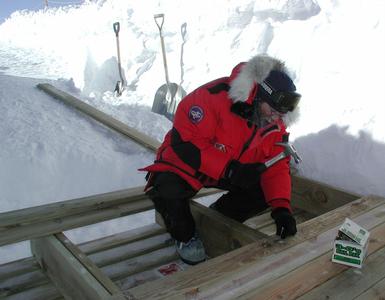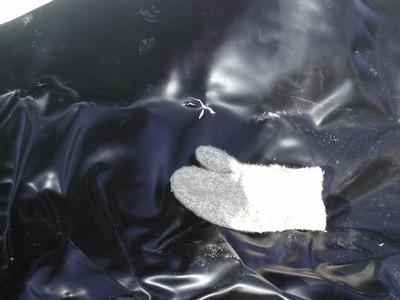27 November, 2001
The project I am currently working on is simple in design. The idea is to construct a tank of frozen water, containing light detectors with in it, that is perfectly light proof. This means that there can not be any holes or defects in the tank, for then outside sunlight could enter the tank and distort the data being recorded.
The intended instructions for designing the tank are pretty easy. First, excavate a hole in the snow large enough and deep enough to hold the tank. Second, construct a platform that the tank can rest upon. The platform is needed to disperse the weight of the tank after it is filled with almost 1000 gallons of water. Third, wrap a thick platic cover around the tank to ensure no light can leak in from any unobserved flaws in the tank. Forth, run a test to make sure the detector is "light-tight", meaning no outside light is entering it. If that test is passed, then the tank is filled with water, wrapped up tight, and basically ready to go!
A good analogy of what I am trying to describe above would be to take a plastic bottle, fill it with water, wrap it in a black bag, and finally bury it in the ground. We are essentially trying to do the same thing...only on a larger scale and under adverse conditions.
This afternoon, the wind blowing much stronger than yesterday, we started on the task of covering the bottom of the tank with a thick, almost rubberlike, plastic cover. The company that supplied the covering stated that it would remain flexible at temperatures as low as -60 F. I am not sure what they meant by flexible, for when we started to unfold the cover, it remained very rigid, resisting our efforts.
Image a stick of chewing gum. Take the gum out of the wrapper and bend it into a U-shape. Try the same thing after leaving the stick of gum in the freezer for an hour. Instead of bending, the gum will fracture. Just like frozen gum, the cover we tried placing around the bottom of the tank began to fracture in numerous places. Within five minutes of removing the cover from the heated SPASE Shack, it became as fragile as glass. Any accidental bump would send a spider-like fracture through the cover...rendering it useless.
This setback frustrated us, for now there was no chance of finishing the project ahead of schedule. Our fear being that this delay would keep us at the South Pole well beyond the upcoming holiday season. It is these types of unexpected circumstances that make working in Antarctica such a challange. We will have to put our heads together to determine an alternative way of making the tank light proof. After dinner, we will meet to brainstorm some ideas.
Biological Data
Saturated Oxygen: 89 %
Pulse Rate: 88
Weather Data
Temperature: -39.2 F
Windchill: -67.7 F

Pounding the last few nails into the wood for the platform.

One of the fractures that developed in the cover due to the intense cold.
Contact the TEA in the field at
.
If you cannot connect through your browser, copy the
TEA's e-mail address in the "To:" line of
your favorite e-mail package.
|
